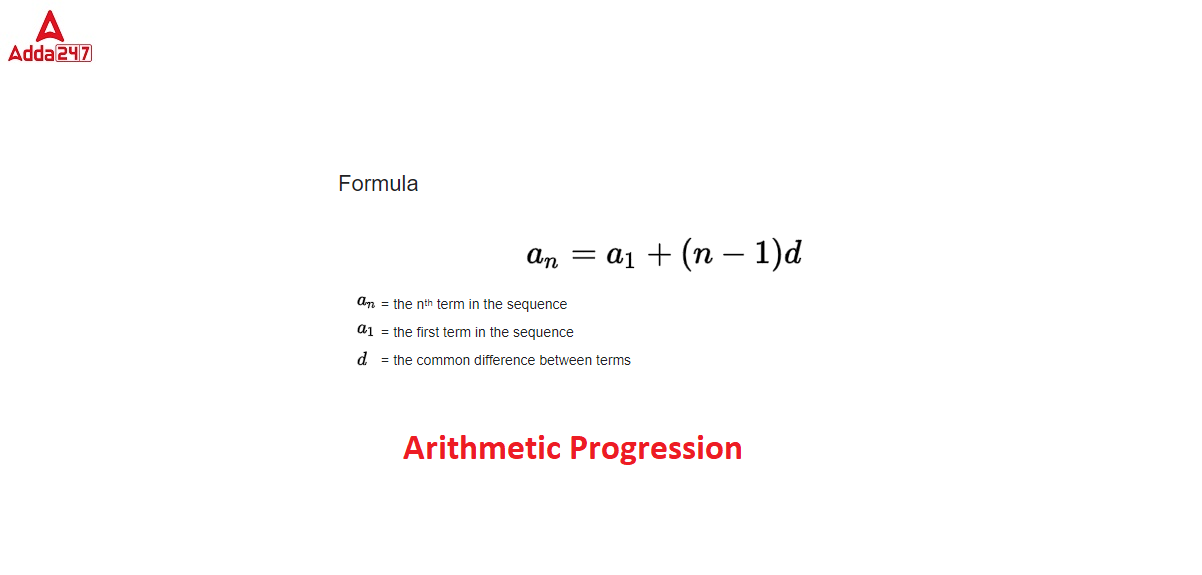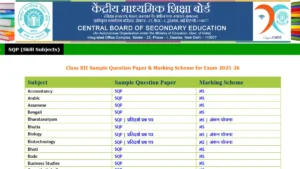Arithmetic Progression (AP)
An arithmetic progression is a sequence of numbers, obtained by adding a fixed number to the preceding term starting from the first term such that the difference between each consecutive term remains the same.
Each of the numbers in the list is called a term and the fixed number is called the common difference of the AP which can be any integer.
For Example, 2,5,8,11…. has a common difference of 3.
AP Formula
The formulas related to Arithmetic Progression (AP) are essential for understanding and solving problems involving AP. Here are the key formulas:
- nth Term of an AP:
The general formula to find the nth term (aₙ) of an AP is: aₙ = a₁ + (n – 1) * d where ‘a₁’ is the first term, ‘n’ is the term number, and ‘d’ is the common difference. - Sum of the First ‘n’ Terms of an AP:
The formula for the sum (Sₙ) of the first ‘n’ terms of an AP is: Sₙ = n/2 * (2a₁ + (n – 1) * d) where ‘Sₙ’ is the sum, ‘n’ is the number of terms, ‘a₁’ is the first term, and ‘d’ is the common difference. - Finding ‘n’ when given ‘aₙ’:
If you know the nth term ‘aₙ’, the first term ‘a₁’, and the common difference ‘d’, you can find the term number ‘n’ using: n = ((aₙ – a₁) / d) + 1 - Finding Common Difference from Terms:
If you are given two terms ‘a₁’ and ‘aₖ’ (kth term), you can find the common difference ‘d’ using the formula: d = (aₖ – a₁) / (k – 1) - Sum of an AP using Last Term:
If you know the last term ‘aₙ’ and the total number of terms ‘n’, you can find the sum using: Sₙ = n/2 * (a₁ + aₙ) - Finding Number of Terms from Sum:
If you’re given the sum ‘Sₙ’, first term ‘a₁’, and last term ‘aₙ’, you can find the number of terms ‘n’ using: n = (2 * Sₙ) / (a₁ + aₙ)
These formulas are essential for solving problems related to arithmetic progressions. Remember to substitute the values of the given terms, common difference, and term numbers to find the desired values such as the nth term or the sum of the terms.
Arithmetic Progression AP Formula Class 10 for General Terms
- The general form of an AP is:
a ,a+d ,a+2d ,a+3d ,….,a+(n−1)d
- An AP with a finite number of terms is called a finite AP having a+(n−1)d as the last term.
For example:
Finite AP: 1,3,5,7,….,25
An AP which neither has a finite number of terms nor has a last term is called an infinite AP.
For example:
Infinite AP: 2,4,6,8…..∞
3 The nth term of the AP: an=a+(n−1)d, where a is the first term of the sequence and d is the common difference.
The Second term: a2=a+(2−1)d=a+d
Similarly, the third term a3=a+(3−1)d=a+2d
The fourth term a4=a+(4−1)d=a+3d and so on till the last term.
Arithmetic Progression Class 10 Notes
arithmetic progression (AP) concepts typically covered in a Class 10 math curriculum. Arithmetic progression is a sequence of numbers in which the difference between any two consecutive terms is constant. This constant difference is called the “common difference.”
Here are the key points you might find in Class 10 notes on arithmetic progression:
- Definition: An arithmetic progression is a sequence of numbers in which the difference between any two consecutive terms is the same.
- Common Difference (d): The constant difference between any two consecutive terms in an AP is called the common difference. It’s denoted by ‘d’.
- nth Term of an AP: The general formula to find the nth term (aₙ) of an AP is given by:
aₙ = a₁ + (n – 1) * d
Where ‘a₁’ is the first term, ‘n’ is the term number, and ‘d’ is the common difference. - Sum of the First ‘n’ Terms: The sum of the first ‘n’ terms of an AP is given by the formula: Sₙ = n/2 * (2a₁ + (n – 1) * d) Where ‘Sₙ’ is the sum, ‘n’ is the number of terms, ‘a₁’ is the first term, and ‘d’ is the common difference.
- Finding ‘n’ when given ‘aₙ’: The formula to find the term number ‘n’ when given the nth term ‘aₙ’ is: n = ((aₙ – a₁) / d) + 1
- Finding Common Difference from Terms: If you are given two terms ‘a₁’ and ‘aₖ’ (kth term), you can find the common difference ‘d’ using the formula: d = (aₖ – a₁) / (k – 1)
- Sum of an AP using Last Term: If you are given the last term ‘aₙ’ and the total number of terms ‘n’, you can find the sum using: Sₙ = n/2 * (a₁ + aₙ)
- Finding Number of Terms from Sum: If you’re given the sum ‘Sₙ’, first term ‘a₁’, and common difference ‘d’, you can find the number of terms ‘n’ using: n = (2 * Sₙ) / (a₁ + aₙ)
These are some of the fundamental concepts covered in Class 10 when studying arithmetic progressions. Be sure to practice various problems to understand these concepts thoroughly.
Arithmetic Progression AP Formula Based Examples
AP Formula Example 1:
An AP has a first term 3, common difference 4. Find the third and fifth term of the AP.
Ans:
a=3, d=4
a3=3+(3−1)4
a3=11
Similarly,
a5=3+(5−1)4
a5=19
4 nth term of an AP from the end: tn=L−(n−1)d, where L is the last term of the AP.
AP Formula Example 2
An AP has a common difference 2 and last term 24. Find the fourth term of the AP from the end.
Ans:
d=2, L=24
t4=24−(4−1)2
t4=18
Sum of the terms of an AP:
Sum of n terms of an AP if first term and common difference is given:
S=n2(2a+(n−1)d)
Sum of n terms of an AP if first term and last term l is given:
S=n2(a+l)
AP Formula Example 3
Find the sum of the first 10 terms of the AP 1,4,7,10…..34.
Ans:
S=102(2×1+(10−1)3)
=5(2+27)
=5×29
=145
Class 10 students can now join the board exam preparation batch by Adda247 and ace their board exam.
Arithmetic Progression Class 10
An arithmetic progression is a sequence of numbers that differ from each other by a common difference. For example, the sequence 3, 6, 9, 12, ….. is an A.P. with a common difference of 3.
Common Difference:
The difference between the two consecutive terms of an A.P. is known as the common difference. For example, in the sequence 3, 6, 9, 12…., the common difference is 3.
The classification of the common difference:
- Positive, when the A.P. is increasing.
- Zero, when the A.P. is constant.
- Negative, when the A.P. is decreasing.
General Form of an Arithmetic Progression
Say the terms a1, a2, a3……an are in A.P. If the first term is ‘a’ and its common difference is ‘d’. Then, the terms can also be expressed as follows.
1st term a1 = a
2nd term a2 = a + d
3rd term a3 = a + 2d
Therefore, we can also represent arithmetic progressions as:
a, a + d, a + 2d, ……
This representation is called the general form of an Arithmetic Progression.
Finite and Infinite A.P.
In the finite A.P., the numbers of terms are finite, and the last term of the A.P. exists.
In the infinite A.P., the number of terms is infinite, and the last term of an A.P. doesn’t exist.
Arithmetic Progression AP Formula for Sum
The sum of n terms of an A.P. with ‘a’ as its first term and ‘d’ as its common difference is given by:
Sn=n2(2a+(n−1)d)
Arithmetic Mean
Arithmetic Mean is simply the average of two numbers. If we have two numbers n and m, we can add a number L in between them so that the three numbers form an arithmetic sequence like n, L, m. In this case, the number L is the arithmetic mean of the numbers n and m. On the basis of the properties of Arithmetic Progression, we may say:
L – n = m – L, that is, the arithmetic mean of n and m.
L=n+m2
Learn more about Arithmetic Progression
Arithmetic Progression AP Formulas
Here we have provided all the arithmetic formulas in the table below for class 10 Students.
| Sequence | a, a+d, a+2d, ……, a + (n – 1)d, …. |
| Common Difference | d = (a2 – a1), where a2 and a1 are successive term and preceding term respectively. |
| General Term (nth term) | an = a + (n – 1)d |
| nth Term from the last term | an’ = l – (n – 1)d, where l is the last term |
| Sum of first n terms | Sn = n/2[2a + (n – 1)d] |
| Sum of first n terms if first and last term is given | Sn = n/2[first term + last term] |
Properties of Arithmetic Progressions Class 10 Notes
- If the same number is added or subtracted from each A.P. term, the resulting terms in the sequence are also in A.P. with the same common difference.If each term in A.P. is divided or multiplied by the same non-zero number, the resulting series is also in A.P.
- Three numbers x, y, and z will be an A.P. if 2y = x + z.\
- A series is an A.P. if the nth term is a linear expression.
- If we pick terms from the A.P. in the regular interval, these selected terms will also make an A.P.
- If the terms of an arithmetic progression are increased or decreased with the same amount, the resulting sequence will also be an arithmetic progression.
Important Points on Arithmetic Progressions for Class 10
- If each term of the A.P. is increased, decreased, multiplied, or divided by the same non-zero constant, the resulting sequence would also be in A.P.
- In the A.P., the number of terms equidistant from start to end will be constant.
- In order to solve most of the problems related to A.P., the terms can be conveniently taken as:
- 3 Terms: (a – d), a, (a + d).
- 4 Terms: (a – 3d), (a – d), (a + d), (a + 3d).









 CBSE Class 12 Sample Paper 2026 with Sol...
CBSE Class 12 Sample Paper 2026 with Sol...
 CBSE Class 12 Physics Blueprint 2025-26:...
CBSE Class 12 Physics Blueprint 2025-26:...
 CBSE Class 10 Sample Paper 2025-26 with ...
CBSE Class 10 Sample Paper 2025-26 with ...


















